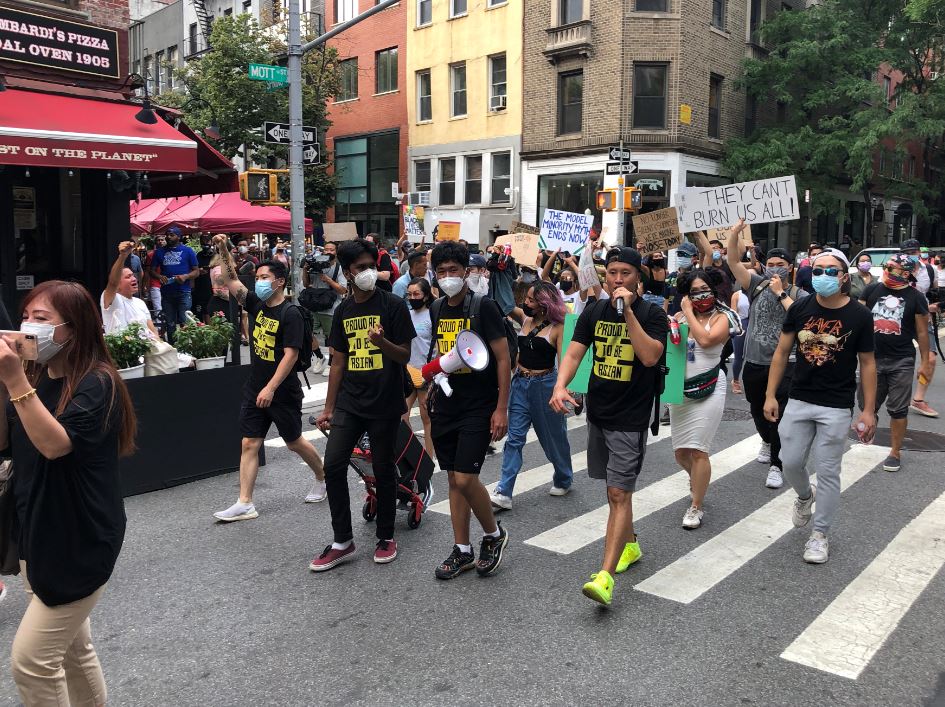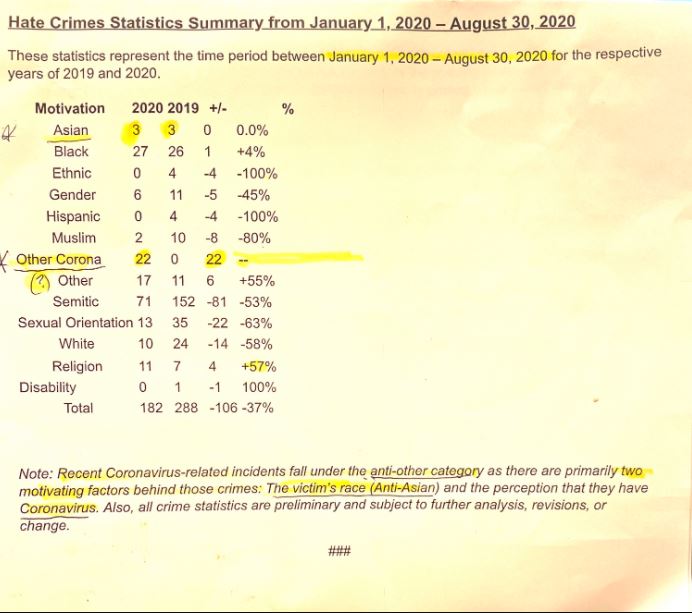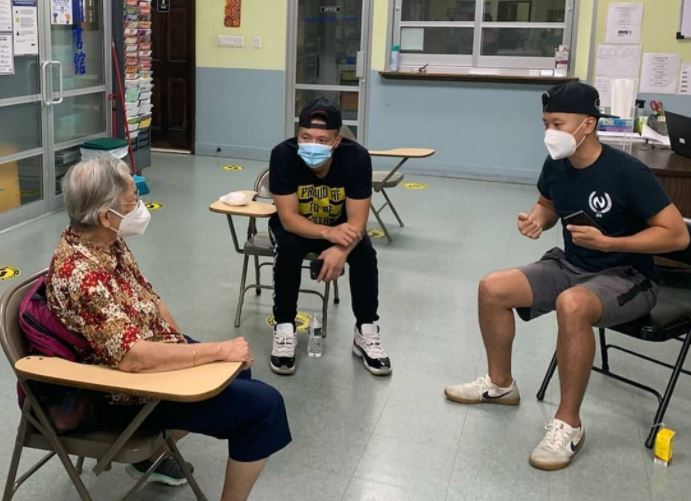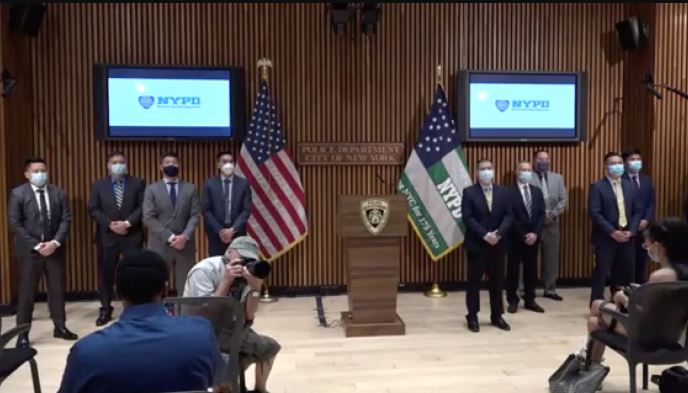By Lillian Bit and Nancy Hung, AsAmNews Staff Writers
An 89-year old grandma in Brooklyn is set on fire. Police make arrests, but the suspects are not charged with a hate crime. An Asian woman is called a racial slur. Police refuse to investigate it as a hate crime.
AsAmNews decided to document why this is occurring by taking a closer look at what is likely the first police task forced dedicated to Asian hate crimes.
The New York Police Department created its Asian Hate Crime Task Force (pictured above) this past summer. NYPD Chief of Detectives Rodney Harrison together with NYPD Detective Inspector Stewart Loo started the idea in May 2020 and it was officially announced on August 18. The NYPD noticed an increase in anti-Asian hate crimes beginning in March and Asian victims were not always able to communicate easily because of language and cultural differences and distrust of the police.
Detective Loo leads the Asian Hate Crime Task Force comprised of 25 Asian American detectives who speak a total of 9 languages including Cantonese, Mandarin, Shanghainese, Korean, Fukienese, and Tagalog. Deputy Inspector Stewart stressed why it was important to form this task force. “We are taking the proactive approach by bridging the communication gap and reaching out to the victims. It is about having the right person with the right corporate knowledge to ask the right questions, building rapport and trust” says Loo.
LATEST STORIES
The permanent task force are all volunteers. They are called out after a crime incident – if the incident falls within their job function. Detective Loo will then assign the specific language or cultural capability needed from the 25 member force according to their availability. They usually have enough people to cover. The assigned detective or detectives investigate the hate crime and follow through all the way to prosecution. They cover all five boroughs.

Asamnews attended two zoom Asian Hate Crime Task Force meetings- one was a town hall meeting sponsored by the Committee of 100 and the other one was held in the Office of Brooklyn DA Eric Gonzalez.
Our goal is to highlight the differences between a hate crime, a regular crime and freedom of speech. Many people wonder why a crime is not defined as a hate crime and this is discussed. We use hate crime data obtained from the NYPD to show numbers of Asian hate crimes and how categories of data can be sometimes be misinterpreted, miscategorized or under reported. Questions about racial and ethnicity identification in crime reports are answered. We based our information from data and findings from the two zoom meetings and the NYPD websites, and data collection agencies on hate crime.
In addition we also interviewed a police officer not from the Hate Crime Task Force. He wished to remain anonymous, so we will call him PO XYZ. He was able to answer most of our questions. We choose him because after countless attempts, we were unable to interview anyone from the NY Asian Hate Crime Task Force due to their busy schedules.
When we talk about hate crimes, it’s important to know the difference between regular crimes, hate crimes and freedom of speech. These terms are defined by the NYPD website:
Freedom of Speech is protected under the Constitution. According to the NYPD: “offensive or hateful speech is still just speech and is protected.” “However, a hate crime is a criminal act that is motivated in whole or substantial part by the perceived identity of the victim.” It is clear according to the NYPD that “For example, a person who calls another person an insulting name… it is just a name and not a crime. Although you may feel the name is hateful and offensive… it is considered freedom of speech.
However, if someone calls a person a hateful name because of their race alone… and then assaults them, it then becomes a hate crime.”
“A hate crime or bias incident is any offense or unlawful act that is motivated in whole or substantial part by a person’s, a group’s or a place’s identification with a particular race, color, religion, ethnicity, gender, age, disability, ancestry, national origin or sexual orientation (including gay, lesbian, bi-sexual, and transgender) as determined by the Commanding Officer of the Hate Crime Task Force.”
Most people are familiar with the term crime which falls under the general categories of murder, rape, robbery, assault, burglary, and grand larceny.
The police and high ranking police officials go through a lengthy protocol before they can label a crime –a hate crime. The biggest criterion we took away from this as Stewart Loo says “is the MOTIVE attributed to the perpetrator. What did the perpetrator say at the scene of crime? When police investigate a crime they look at all kinds of criteria. What was the perpetrator doing before and after he saw the victim? Police will examine his social media and any arrest record, ask witnesses questions, and look for videos.
The process according to NYPD Commanding Officer Mark Molinari involves the police on the scene taking the report. If he thinks it may be a hate crime, he must then contact his supervisor and also an executive police officer with at least a rank of Captain or above. In addition, the process continues in collaboration with five district attorneys and then to Molinari. He makes the final decision even though some may disagree on the labeling but the Commanding Officer Molinari’s decision is final.
Because of this sometimes lengthy process compared to a regular crime, a report of hate crime may not be designated right away and sometimes the media will report it as a regular crime until the process of hate crime designation is finished. This of course may be upsetting to the victims and their family and sometimes involve the communities of the victim who will voice their objection to why a reported assault crime is not reported as a hate crime. The media then will also only have a preliminary designation.
In addition, the NYPD admits that this could be a very subjective process because it involves many decision makers. Stuart Loo, Detective Inspector and head of the Asian Crime Task Force said “no matter how a crime is designated, it is still investigated but a regular crime does not have to go through this longer process.”
Why the fuss over the designation hate crime if it is a crime and will still be investigated? “We go after hate crimes very seriously says Molinari, the harm not only affects the victim but may eventually involve the community.”
For example, take the case of the 89-year-old grandma in Bensonhust, Brooklyn who was slapped and her clothes set on fire. The community uproar was great over the burning of the grandma. The community was upset that there was no designation of hate crime to this case. A policeman also told her to go home and call 911 when she showed up to report it at the precinct. This case resulted in a series of protest rallies formed by rapper China Mac and Wil Lex Ham in Brooklyn, Manhattan and as far as Los Angeles and San Francisco.

The formation of the Asian Hate Crime Task Force was discussed as early as May and then formally announced two days after the second China Mac protest rally in Manhattan on August 18.
The seriousness of hate crimes can trigger bigger community responses. Police take these crimes and their labeling seriously. It was mentioned by the NYPD that 9 or 10 policy criteria are used to assist in the determination of a hate crime. This long process can result in a delay in deciding whether a regular crime should be escalated to a hate crime.
One might assume that police may not want to go through the lengthy process- one that involves contacting a supervisor, then a Captain on duty, 5 District Attorneys and finally Molinari who will also assign one of his own detectives to work along with the original reporting policeman.
Asamnews put that assumption to the test. We interviewed NYPD PO XYZ if he thought the reporting of hate crimes by police was accurate. He said “It’s not as accurate as it could be. Some policeman don’t want to bother with the long process of notification protocol because it’s just too much work and they don’t want to have to deal with so many people”
He adds,” If there are too many hate crime reports, it will make the higher ups look bad and the Mayor will look bad and the City Council will ask why the numbers of hate crimes are so large. In addition, during an election year. this could be an added disincentive.”
According to the NYPD police website, “the Hate Crime Task Force is responsible for the statistical data delivered by the Mayor DeBlasio and NYPD Police Commissioner Dermot Shea.
We asked him how much training was required by the Hate Crime Task Force and PO XYZ said not more than one day’s training for him and many others. PO XYZ view on the underreporting of hate crimes and the little training that police get is corroborated by ProPublica in its headline and article DOCUMENTING HATE Hate Crime Training for Police Is Often Inadequate, Sometimes Nonexistent. As the study points out data gathering of hate crimes varies from state to state and some states don’t even report Hate crimes as a category. The FBI gathers hate crime police reports from states, but these states are not required to do so. The Dept. of Justice and the Commission on Civil Rights also gather information, but data is not close to being uniform at all.
AsAmNews is not suggesting that police aren’t doing their jobs. However, paperwork is sometimes a grueling process that many people in many industries really don’t enjoy. The Asian Hate Crime Task Force is only two months old, while data for this year began in January 2020.
The investigative research by ProPublica report suggests that there is room for improvement nationwide.
This is the NYPD crime statistics from Jan-Aug 2020 under Hate Crimes:

There are only three reported Asian hate crimes for 2020 – the same number for 2019. But, On closer inspection there is a new category called Other Corona which is explained in a footnote that this category combines anti-Asian and the perception that Asians have the virus. That number for hate crimes total 22. So the actual number is really 22 Covid- related cases plus 3 non-Covid cases, meaning there have been 25 total hate crime against Asians from January until August 2020. NYPD states there were actually 23 Corona cases – but one Corona case was anti-Semitic. In 2020, the largest Hate crimes numbers are Anti- Semitic total 71. For Blacks 27. For Asians 25. The Asian hate crimes for 2019 were only 3.
This table can be misleading if one doesn’t look closer at the new additional category added called Other Corona which combines anti-Asian and the false perception linking the Coronavirus to Asians.
We found mistakes in this reporting by Newsweek (and other media) which incorrectly stated “Hate crimes against members of the Asian community stayed the same with 3 incidents reported up to Sept 27 both this year and last year.”
They missed the category ‘Other Corona.’
https://www1.nyc.gov/site/nypd/news/pr0902/nypd-citywide-crime-statistics-august-2020
Mark Molinari broke down the 22 Anti -Asian Corona virus related Hate crimes listed:
Manhattan 13
Brooklyn 5
Queens 3
Bronx 2
(Minus 1 anti-Semite Corona virus case)
The Task Force immediately solved six of the first eight cases they received.
In the remaining two cases, the victims were intimidated and refused to cooperate with the police.
The 5 perpetrators in Brooklyn have been arrested.
Police are still working on 15 out of 22 cases
15 Victims were Male, 11 victims Female, Age range between 18-59
7 were Assaults, 2 Menacing, and 12 Aggravated Harassment (a threat to strike with an object but no injury )
The NYPD says that hate crimes have dropped 33 percent this year across mostly all groups except for Asians. Those numbers for Asian Hate crimes is concerning and very high compared to the year before.
However, note that we are only talking about Hate Crimes Statistics which are categorized according to many criteria including race, ethnicity, religion, and sexual orientation.
Regular crimes such as murder, burglary, robbery and car theft are all up except for rape and grand larceny which are down.

So why did the police and District Attorney not designate the case of the “89 yr old grandma” as a hate crime?
“Since the crime was not racially motivated, it will not be labeled a hate crime because the two 13 yr. olds (arrested) never spoke a word, but did slap her and set her shirt on fire,” Detective Loo told AsAmNews. Investigators determined the boys were motivated by their desire of starting fires in garbage cans.
“This is still a crime and unfortunately grandma was in the wrong place at the wrong time, but we still investigate all crimes,” he adds. The boys will be going to family court.
The grandma case would more than likely to be categorized under the general crime category of assault. So the number of general categories of crime are much greater in number than numbers designated as hate crimes which involve specific identity targets.
Why is correct data so important?
The data is used to allocate funds to specific areas where they are needed. The underreporting of Asian Hate crimes ultimately hurts the Asian American community.
“We know there is under reporting by Asians based on their fear of dealing with police, the language barriers and the cultural differences. That’s why the Asian Hate Crime Task Force was formed,” Loo said.
Loo suggests to always report a crime. The Asian Hate Crime Task Force is there to help with language and communication problems. They emphasize that the NYPD will never ask you anything about your immigration status.
In addition, Stop AAPI Hate has received 2700 reports of harassment, discrimination and hate crimes across the US against Asians so far in 2020.
The number one type of harassment in 70 percent of cases is verbal harassment. 43 percent usually occur in businesses. Almost 90 percent of discrimination is based on race closely followed by 69 percent based on ethnicity and 40 percent of that based on being Chinese. 59 percent of the victims are in their 20s and 30s. Women are 2.4 times more likely to report discrimination than men. All this data and more can be found here.
A great deal of questions regarding the identification of race or ethnicity at the time of arrest and in initial media reports were asked during the zoom meetings. We asked PO XYZ if determination of race or ethnicity is or is not usually reported because of policy rules or why media reports use personal descriptions, but no reference to race or ethnicity. Police officer XYZ says “there is nothing in police policy nor is it illegal to report race or ethnicity.”
We obtained the official NYPD “Crime and Enforcement Activity in New York City” by Commissioner Dermot Shea and the entire 25 pages which states on page iii:
“Arrest statistics are drawn from the initial booking data collected by the arresting officer prior to arraignment. The small number of arrest records without race/ethnicity may result from arrestees that have no identification and whose race/ethnicity cannot initially be determined before arraignment or due to administrative omissions in report preparation.
The race/ethnicity of victims are recorded by the officer or precinct clerical staff who are taking the report and rely on that interaction with the victim/complainant/reporter to determine the victims race/ethnicity. The suspect’s description is also recorded at this time but relies on the victim’s assessment of race and ethnicity given their interaction with the suspect.
The arrestee‘s race/ethnicity is recorded as a result of the officers assessment of the individual’s identification and physical characteristics.
The arrestee’s race/ethnicity and victim race/ethnicity may therefore vary due to the different methods of determination.
This may be the reason for the category Other in the Hate Crime Category data posted in the above photo.
Here is the you tube video of the town hall meeting with Detective Inspector Stewart Loo, Police, Commissioner Dermot Shea, District Attorney Mark Molinari and some of our Community leaders in NYC.
How can we use this information to help the community?
Solutions for our community when faced with a possible crime:
We urge you to brainstorm your own ideas on how to prevent a crime from escalating and to practice your methods at home. Some of the ideas originated from us.
1. Remember that hateful words and racial slurs, no matter how horrendous and hurtful it sounds, is NOT a crime. 70 percent of hate crimes begin with racial slurs. It is considered Freedom of Speech and protected by the Constitution. By knowing this, educate yourself and others to not let the situation escalate.
Our community needs to understand how to engage the racist without being arrested. According to police – the first one who elevates this into an assault can be arrested. Is it worth it to escalate an incident into a physical one?
A much better method is to take out your camera and videotape the person from a distance and ask other bystanders to help take out their cameras and say: “I am documenting this for the police in case. Please help me as a witness with your cameras too.” (To bystanders)
Make your video viral to let our community know this is a good way to de- escalate a crime. This can also give the victim more power and diminish the power of the perpetrator. It also documents the crime for the police.
2 .Go Live on Facebook so people know where you are and help you get located. You can help elderly use this method by setting them up on FB and show them how to go live so people can see them. You can say something about getting help this way. Especially when they are alone. They can videotape also.
3. Preprogram 911 on your phone and keep your finger close in case you need it – Help teach senior citizens how to use this and all the recommended solutions and practice them over and over.
4.Practice Bystander Intervention: Intervene and Act when possible to help a victim giving them acknowledgment such as “are you alright, I see this man is harassing you” – take out your phone and help record what is going on which gives the victim help and produces evidence for the police. It takes away the power of the perpetrator by de-escalating the situation.
5. Always call 911 when a crime is in progress no matter how small you think it is. Police gather information this way to stop further harassment and to prevent a crime from escalating. Call your local precinct if it’s not a crime in progress. Police mentioned that if no calls or reports are made, they have nothing to go on. Report, report, report!
Report crimes. If you don’t report crimes, there is no record of crime or hate crimes and that means inaccurate statistics.
NOTE: NYPD Do not and will never ask about immigration
This is important in order to get sufficient support and protection. To report a hate crime or any emergency, call 911. Non-emergencies should be reported to the local precinct.
For general questions, please contact the OPHC team.
New York City Police Department
Hate Crime Task Force
19 ½ Pitt Street 3rd Floor
New York, NY 10002
To keep communication open with the Asian Hate Crime Task Force
1. Hold Zoom meetings. The Asian Crime Task Force wants the community to develop a relationship of trust.
If more people have experiences police were able to take care of, then the community gets to know them
2. Organize town hall meetings online or eventually in Covid- free meetings
3. Produce a dedicated website for the Asian Hate Crime Task Force: Detective Loo said they will be working on one
4. Designate a dedicated telephone number to report a hate crime:
How Community Can Join together with Police
1. You can contact Detective Stewart Loo or Edward Molinari to set up community meetings with the Asian Hate Crime Task Force
2. Produce a PSA: Educating the public about Asian Bullying. Look for ways to disassociate the coronavirus from Asians.
3. Create a dialogue between perpetrators and victims (Admittedly a long term approach, but some activist groups want less policing and more dialogue.)
4. Educate kids in schools about Asian bullying and Covid19.
5. Educate parents what they should teach their children about racism
Organizations That You Can Join or Call
1. Apex for Youth: In Manhattan October is Anti-Bullying Month
2. You can join the Guardian Angels or Block watches. Both are in Manhattan and the Angels are in other Boroughs (FYI: Normally police do not work with other outside groups like the Guardian Angels
3. Reach out to community organizations, civil groups, activists, local law enforcement officials.
Share ideas and work together.
The Chinese-American Planning Council’s mission is to promote the social and economic empowerment of Chinese American, immigrant, and low-income communities.
The Asian American Federation‘s mission is to raise the influence and well-being of the pan-Asian American community through research, policy advocacy, public awareness and organizational development .Established in 1989, the Federation is a pan-Asian non-profit organization representing a network of community service agencies in the Northeast. These agencies work in the fields of health & human services, education, economic development, civic participation, and social justice.
Committee Against Anti-Asian Violence (CAAAV)
191 East 3rd Street
New York, NY 10009
212-473-6485
212-473-5569 FAX Founded in 1986 to organize Asian communities in the New York City area to combat racist violence. Through community education and organizing efforts, CAAAV strives to develop leadership within the Asian communities to speak out and effect change in public policies.
Organization of Chinese Americans (OCA)
1001 Connecticut Avenue, N.W., Suite 707
Washington, D.C. 20036
202-223-5500
202-296-0540 FAXA national nonprofit, nonpartisan civic organization advocating for the welfare of Chinese Americans. OCA has an internal task force on anti-Asian violence. It monitors court cases and is involved with specific cases by acting as legal counsel and providing financial resources. OCA materials include a quarterly newsletter, which offers updates on cases, and a new major publication on hate crimes.
Asian American Legal Defense & Education Fund
99 Hudson Street, 12th Floor
New York, NY 10013
212-966-5932
Community education, legal counseling and advocacy on behalf of victims of anti-Asian violence.
4. Reach out to schools to teach the children about hate crime. Bias is learned in childhood. Here is a wonderful story targeted to school children created by Barbara Yau, founder of CAACNYC -Concerned AsAm Citizens of NYC and her daughter Kyra Skye Yip.
5. When you see hate crime in the community, show support and urge victim to report the crime. Or if you see a hate crime, report it. Did you know there is an app for that?
6. Reach out to young people by hosting a diversity and inclusion day on campus like some companies do for their workplace. Holding events for and presentations for panelist to talk about their cultures.
7. Many of our non-English speaking Chinese community only read the Chinese Newspapers, watch Asian television and listen to Asian radio stations. Perhaps the community organizations can collaborate with the Chinese Newspaper publishers, Television or Radio podcast to get a dedicated section and time slot to educate our Asian community on a daily basis about important issues like:
a. Hate crimes – what, where, when, who and how
b. What benefits they may be entitled to and may not know about because of communication gaps
The Office of Victim Services provides a safety net if you have no other way to pay for costs – including but not limited to medical bills, counseling expenses, burial and funeral costs, and lost wages – resulting from being the victim of a crime. Your family members also may be eligible for help.
c. Why voting is important, learn about the candidates and how to vote.
d. Covid news and safety alerts.
8. Make brochures and flyers This brochure is from California.
9. Take self-defense classes
AsAmNews has Asian America in its heart. We’re an all-volunteer effort of dedicated staff and interns. Check out our new Instagram account. Go to our Twitter feed and Facebook page for more content. Please consider interning, joining our staff, or submitting a story.








